
Richard Seeley/Courtesy photo
Just as tourists are making their return to Summit County to kick off the summer this Memorial Day Weekend, millions of birds are also making an annual migration to nest and breed in Colorado’s Rocky Mountains.
For those hoping to find some peace in nature amid busy barbecues and family get-togethers this holiday weekend, birding can be a reflective and solitary experience that is accessible to all Summit County residents and visitors.
“With north of 350 species of bird in the state, you could never leave Colorado and still see birds from around the world,” Audubon Rockies Community Science Coordinator Zach Hutchinson said.
Every spring, more than a hundred million birds migrate to and through the Rocky Mountains, Hutchinson said, though migration tends to slow toward the end of May. Still, about 1.5 million migrating birds are expected to cross Colorado airspace each night over Memorial Day weekend, he said.
Birding is an inexpensive activity that doesn’t require anything more than one’s own eyes and ears, Hutchinson said, adding that studies have shown that observing birds and listening to their songs has been shown to have positive impacts on mental health.
“You can find birds just about anywhere,” Hutchinson said. “It’s one of the great things about birding as a hobby.”

Ruth Carroll/Courtesy photo
From their vibrant colors to their intonated warbles, clicks and calls, birds represent the broad diversity that can be found in nature, Hutchinson said. In birds range in size from the smallest hummingbird, which is just a few inches long, to hawks and eagles, which can boast wingspans of several feet.
Many flycatchers, warblers, vireos and hummingbirds are still completing the last leg of their spring migrations, Hutchinson said, and many other birds have already arrived at their spring mating grounds. So now is a great time to get outside and enjoy the sights and sounds of birding.
This time of year, many birds will be traveling along the “green highways” that border rivers and streams, Hutchinson said. Still, birds can be found in almost any habitat, even those at some of Colorado’s highest elevations, he said.
Early mornings just before and after sunrise is often the best time to observe birds — they tend to be active during these early hours and are more likely to be heard singing their songs, he said.
Here are five birds to keep an eye out in Summit County for this weekend.
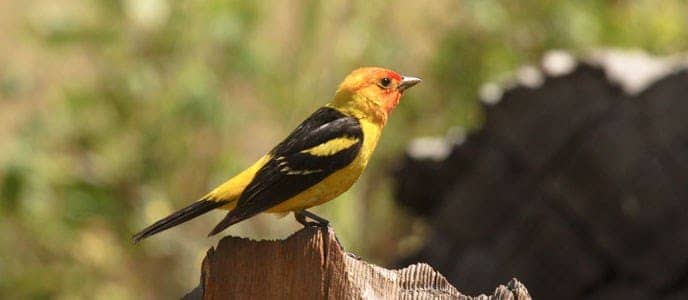
National Parks Service/Courtesy photo
Western tanager
Catching a glimpse of a male Western tanager is a bit like looking at a flame. With an orange-red head, brilliant yellow body and coal-black wings, back and tail, these American songbirds are members of the cardinal family and a sure sign of spring in the Rocky Mountains.
Western tanagers tend to prefer higher-elevation riparian habitats with large coniferous trees, Hutchinson said. Areas along the Blue River or any wooded area along running water could be a good place to spot one.
“They’re the kind of bird that will really give you a spark to say, ‘Hey, I want to learn more about this bird and the ones around us,’” Hutchinson said.
Western tanagers spend much of their time in the mid- to upper-canopy but are known to perch out in the open and sing, Hutchinson said. Their distinctive song, sounds like “an American robin that woke up with a sore throat,” he said.
During migration season, Western tanagers can be found at all elevations, but they tend to mate in areas above 6,500 feet of elevation, Hutchinson said. Females have more muted colors than their male counterparts, he added.
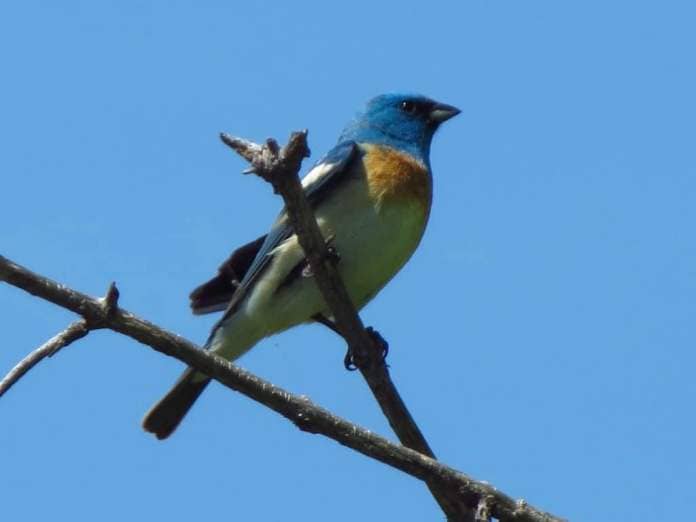
Michael Wheeler/National Park Service
Lazuli bunting
Another songbird known for its bright colors, the lazuli bunting is named after the gemstone lapis lazuli — a tribute to its bright blues. Adult breeding males are colored blue above, with a pumpkin-toned breast and white belly. Females are a grayish-brown above with a blue tinge to their wings and tails and a tan breast.
These small birds winter down in Latin America but return to the Rockies each year to breed in areas above 9,500 feet, Hutchinson said. During breeding, lazuli buntings prefer dense shrubbery near streams and rivers, especially areas where juniper and sagebrush meet.
Brushy hillsides, wooded valleys, thickets and residential gardens are great places to spot a lazuli bunting in Summit County. The birds often sing from exposed perches in low trees and shrubs and eat everything from seeds to insects, Hutchinson said.
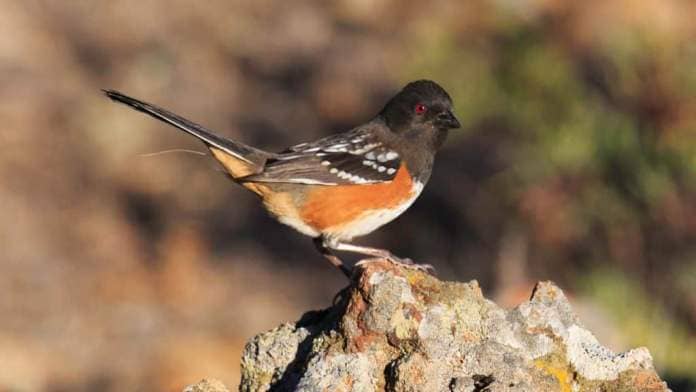
Tim Hauf/National Park Service
Spotted towhee
With a distinct call that sounds a bit like someone saying, “drink your tea-he-he-he,” spotted towhees can be easily identified by their song alone. Catching a glimpse of one can be it’s own reward — male spotted towhees have a jet-black throat and upper half with white spots on their wings and back, a red flank and white belly.
A ground sparrow, spotted towhees spend much of their time scratching for seeds and insects in leaf litter, Hutchinson said. Even if they’re not singing their “drink your tea” song, they can often be heard rooting in the ground before they are seen.
Most easily spotted in open, shrubby habitat with thick undergrowth, spotted towhees are also common visitors to backyards, forest edges and overgrown fields. They are known to hop over the ground beneath dense shrubs while climbing onto lower branches in search of insects or fruit to eat.
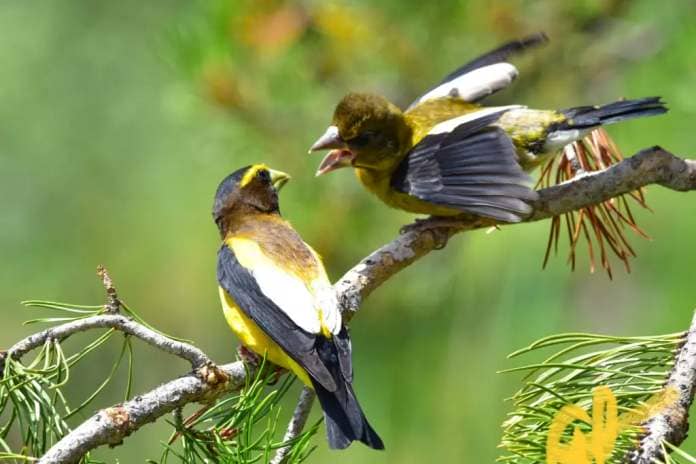
Beverly Taylor/Courtesy photo
Evening grosbeaks
A rarer bird that Summit County visitors might spot this holiday weekend is the evening grosbeak, a species “of great conservation need,” accoring to Hutchinson. Since the 1970s, populations of these large, heavyset finches have declined by 90%, he said, making sightings less common.
Adult males are yellow and black with prominent white patches on the wings and dark heads with a yellow stripe over their eye. Females and immature evening grosbeaks tend to be mostly gray, with white and black wings and a hint of greenish-yellow on their neck and backside.
“They’re called grosbeaks because they have really big beaks,” Hutchinson said. “So, their beaks are ‘gross’ as in big or in excess.”
Unlike most other species migrating this time of year, evening grosbeaks don’t migrate annually to mate but rather are “eruptive migrants” — migrating more sporadically in big eruptions when food becomes scarce in northern ranges, forcing them south.
Sometimes found in backyard bird feeders, evening grosbeaks breed in spruce-fir, pine-oak, pinyon-juniper and aspen forests in high-elevation areas throughout the Rockies and are especially easy to spot on berry producing plants, Hutchinson said.
Like many birds, evening grosbeaks have suffered from human activities that have led to a loss of habitat and introduced invasive species, he added.
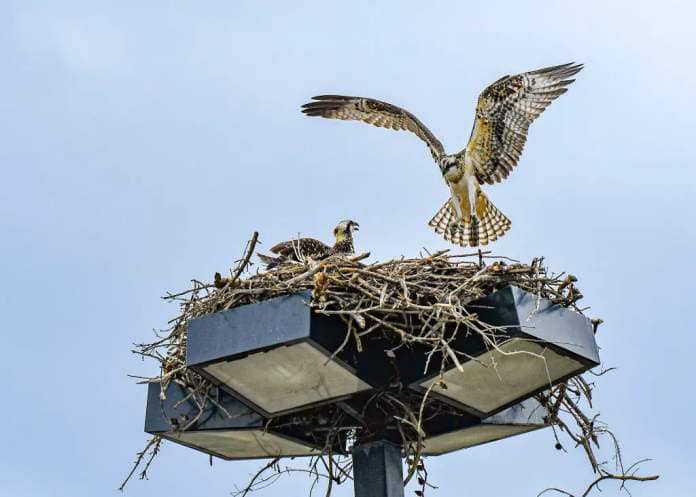
Steve Johnson/Courtesy photo
Osprey
For those hoping to see larger birds of prey, ospreys are easily spotted anywhere along the Blue River or Dillon Reservoir and can provide a spark of excitement for those who catch them diving for fish.
With a white breast, neck and head, ospreys have dark colored wings and brown-black bands across their eyes. Once severely endangered due to widespread use of pesticides such as DDT, ospreys are now found across North America and are considered an environmental success story.
Ospreys are known for soaring over lakes and rivers in hunt of prey and for building nests on utility poles and other infrastructure. This spring in Silverthorne, an osprey couple attempted to build a nest on a crane in an active construction site.
Lucky for the birds, the community came together to hoist a nesting platform as an alternative home for the birds. That osprey couple moved into the new home and can be easily spotted in their nest behind the Dillon Ranger District along the Blue River.


